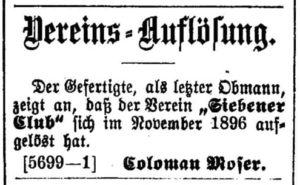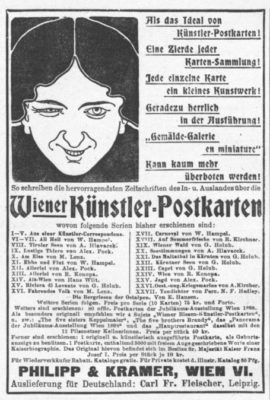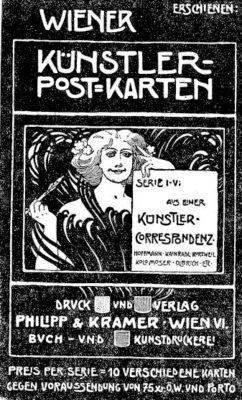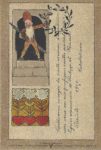The Austrian publisher and printer Philipp & Kramer’s first venture into picture postcards in 1897 coincided with both the birth of Art Nouveau and what many consider the golden age of picture postcards (1898-1918). The invention of the postcard can be traced to Austria, with the first postcard printing on October 1st, 1869. In the decades that followed, Austria also became the leader in the development of new printing techniques and the production of picture postcards for foreign markets like England and France.
Philipp & Kramer began printing books and posters before moving into postcard printing in 1897. When Philipp & Kramer set about producing Series I-V, they had not only the best lithographic printers at their disposal, but also a market that had eagerly embraced the new medium. They went on to produce a total of 52 series in their Wiener Kunstler Poskarten Series, featuring designs from leading illustrators at the time such as Rudolf Kirchner, Walter Hampel, Maximillian Lenz, and Gottlieb Thoedore Von Kempf.
- Philipp & Kramer Advertisement showing the full series.
- Philipp & Kramer Advertisement announcing Series I-V
SIEBENER CLUB
For series I-V entitled Aus einer Knstler-Correspondez, Philipp & Kramer approached the artists of the Siebener Club (The Seven Club), a group of likeminded artists who met every thursday at the either the Blaues Freihaus or the Café Sperl on Gumpendorferstrasse. The origins of the club can be traced as far back as the end of 1892 when the original seven friends in the group –Josef Urban, Josef Hoffmann, Josef Olbrich, Adolf Karpellus, Leo Kainradl, Koloman Moser, and Ludwig Koch were students at the Kunstgewerbeschule (the Academy and the School of Applied Arts). From the onset, the club functioned as an artists collective, with members collaborating together on various illustrative projects and signing their works with their monograms and a “C7” for the group.
One of the early collaborative projects in 1895 was the magazine Für die Jugend des Volkes (For the People’s Youth) published by the Vienna teachers’ union Die Volksschule and featuring over 70 illustrations and a story by Koloman Moser. Other participations by the group included illustrations for both the 1895 and 1896 Gschnasfest (Costume Ball) catalogues, dance cards, and party favours, and a three-page illustration supplement in the periodical Der Architecht. In addition to a few other smaller contributions, the output of the Siebener Club was by no means large suggesting that the primary aim of the group was to form artistic alliances rather than seek commercial success. In the years that followed, more artists would join the group, exceeding the original seven members. By November 1896 when Koloman Moser– the group’s de-facto president gave the club official status – the group had grown to 36 members including many friends and family of the original members, such as Moser’s own sisters Charlotte and Leopoldine, and Adolf Kratochwilla- the owner of Café Sperl.
From its inception, the Siebener Club had already established a tradition of corresponding with each other using hand-drawn postcards in pen and ink and colour washes. Early in 1895, these cards got the attention the attention of Philipp & Kramer who chose 50 out of a supposed 1000 original artist designs for their Series I-V. Released in December 1897, the designs featured decorative Jugendstil borders and stylized images of women, foreshadowing some of graphic elements that Moser and Hoffmann would further develop in the Vienna Secession’s graphic journal Ver Sacrum, as well as the Secession’s own promotional postcards. To mark the Paris Exposition Universelle in 1900, Philipp & Kramer also printed a special series known as the ‘Zudruck Paris Edition’ (Overprint Paris edition), which featured a note by the publishers on the front offering free samples and a list of the first 52 series on the back.

Announcement by Koloman Moser announcing the disbanding of Siebener Club. (Wiener Zeitung nr. 129, May 29, 1900, pg. 16. Vienna National Library Archives)
The series also seemed to mark the decline of Siebener Club. We can attribute this to Moser and Hoffmann’s split from the Kunstlerhaus (Vienna’s main exhibiting body) on May 24, 1897 to join the newly formed Vienna Secession. Many other club members would follow shortly after, including Joseph Olbrich and Max Kainradl. While the remaining members of Siebener Club continued to meet for another 2 years, it was officially disbanded by Koloman Moser in December 1900.
ATTRIBUTION
Because the members of the Siebener Club used monograms to sign their work, correctly attributing the designs has been difficult. Monograms belonging to Koloman Moser, Max Kainradl, Josef Hoffmann, Josef Olbrich, and Leo Kainradl appear the most throughout the series. Other monograms in the series belong to Friedrich Pilz, Johann Kotera, Adolf “Dolo” Karpellus, and Rudolf Konopa. Nevertheless, some monograms remain unknown to this day.
Some of the postcards bear the mark of the Siebener Club (C7) while others are marked with the monogram of a single artist. There is speculation as to whether the double, triple, and multiple monograms that appears on some of the cards were meant to signify a collaboration in the specific design, or rather the artists involved in the correspondence. It seems unlikely, for example, that all eight artists contributed to the design of Series III/10, but rather that these were the Siebener Club artists contributing to the entire series.
Some postcards in the series have no monogram either because they were initially unsigned or the monogram was removed during the lithographic transfer. This is the case in V/8 by Leo Kainradl whereby the original design sold by the auction house Wiener Werkstätte Postkarten on August 8, 2009 shows his monogram at the bottom right.
-Roberto Rosenman, 2019.
Bibliography
- Christian Witt-Dörring (Editor), Koloman Moser: DESIGNING MODERN VIENNA, Neue Galerie, Museum for German and Austrian Art, 2013
- Pichler, Gerd. “The Siebener Club”, Rudolf Leopold, Gerd Pichler, Leopold Museum (Editors) Koloman Moser 1868–1918, Prestel, 2007
LIST OF SIEBENER CLUB MEMBERS
[twocol_one]Original 7 members of the group:
Josef Urban
Josef Hoffmann,
Josef Olbrich,
Adolf Karpellus
Leo Kainradl
Ludwig Koch
Koloman Moser[/twocol_one] [twocol_one_last]Other known members:
Friedrich Pilz
Gottlieb Theodore Von Kempf
Leo Kainradl
Gustav Jahn
Hans Dietrich (sculpture)
Josef Grünhut
Arthur Kaan
Franz Xaver Pawlik
Carl Schwager
Karl Stöger
R. Vidale
Max Fabiani
Otto Wagner
Euge Von Blaas
Max Kurzweil
Charlotte Moser (Koloman Moser’s sister)
Leopoldine Moser (Koloman Moser’s sister)
Adolf Kratochwilla (the owner of Cafe Sperl)[/twocol_one_last]
SERIES I-V
- Leo Kainradl, (with Siebener Club Monogram) Philipp & Kramer, Series I/1. © Collection of Alastair Mason.
- Josef Hoffmann. Philipp & Kramer, Series I/2 © Collection of Alastair Mason.
- Leo Kainradl, Philipp & Kramer, Series I/3.
- No monogram (Likely Josef Hoffmann), Philipp & Kramer, Series I/4
- Koloman Moser, Philipp & Kramer, Series I/5
- No monogram (likely Koloman Moser), Philipp & Kramer, Series I/6. © Collection of Alastair Mason.
- Leo Kainradl, Philipp & Kramer, Series I/7. © Collection of Alastair Mason.
- Leo Kainradl, Philipp & Kramer, Series I/8.
- No monogram (likely Koloman Moser), Philipp & Kramer, Series I/9
- No monogram (likely Koloman Moser), Philipp & Kramer, Series I/10.
- Josef Hoffmann and Leo Kainradl, Philipp & Kramer, Series II/1.
- Artist Unknown, Philipp & Kramer, Series II/2 © Collection of Alastair Mason.
- No monogram, Philipp & Kramer, Series II/3. © Collection of www.wiener-werkstaette-postkarten.com
- No monogram (likely Leo Kainradl). Philipp & Kramer, Series II/4 © Collection of Alastair Mason.
- No monogram (likely Koloman Moser), Philipp & Kramer, Series II/5. © Collection of Alastair Mason.
- Koloman Moser, Philipp & Kramer, Series II/6.
- Koloman Moser, Philipp & Kramer, Series II/7
- No monogram (likely Leo Kainradl), Philipp & Kramer, Series II/8.
- Koloman Moser,Josef Hoffmann, F. Kruis. Philipp & Kramer, Series II/9. © Collection of Alastair Mason.
- Koloman Moser, Josef Olbrich. Philipp & Kramer, Series II/10
- Leo Kainradl, Max Kurzweil. Philipp & Kramer, Series III/1.
- Leo Kainradl, Philipp & Kramer, Series III/2.
- Leo Kainradl, Philipp & Kramer, Series III/3. © Collection of Alastair Mason.
- Koloman Moser, Philipp & Kramer, Series III/4. © Collection of Alastair Mason.
- No Monogram (likely Koloman Moser and Josef Hoffmann). Philipp & Kramer, Series III/5. © Collection of Alastair Mason.
- Siebener Club Monogram (likely by Koloman Moser). Philipp & Kramer, Series III/6
- Koloman Moser, Philipp & Kramer, Series III/7
- Leo Kainradl, Philipp & Kramer, Series III/8. © Collection of Alastair Mason.
- Leo Kainradl, Philipp & Kramer, Series III/9
- In order from top: A. Karpellus, Koloman Moser, Josef Hoffmann, F. Pilz, M. Kurzweil, A. Pock, unknown, Leo Kainradl. Philipp & Kramer, Series III/10
- Max Kurzweil, Leo Kainradl. Philipp & Kramer, Series IV/1
- Unkown monogram, Leo Kainradl, Philipp & Kramer, Series IV/2
- Leo Kainradl, Philipp & Kramer, Series IV/3
- Leo Kainradl, Philipp & Kramer, Series IV/4
- Koloman Moser, Josef Hoffmann, and two unknown monograms. Philipp & Kramer, Series IV/5
- No monogram (likely Koloman Moser). Philipp & Kramer, Series IV/6. © Collection of Alastair Mason.
- Koloman Moser, Philipp & Kramer, Series IV/7
- Leo Kainradl, Philipp & Kramer, Series IV/8
- No monogram (likely Leo Kainradl). Philipp & Kramer, Series IV/9. © Collection of Alastair Mason.
- Leo Kainradl & Josef Hoffmann. Philipp & Kramer, Series IV/10
- Koloman Moser, Philipp & Kramer, Series V/1.
- Artist Unknown, Philipp & Kramer, Series V/2. © Collection of www.wiener-werkstaette-postkarten.com
- Artist Unknown, Philipp & Kramer, Series V/3. © Collection of www.wiener-werkstaette-postkarten.com
- Artist Unknown, Philipp & Kramer, Series V/4
- Koloman Moser, Philipp & Kramer, Series V/5
- Leo Kainradl, Philipp & Kramer, Series V/6. © Collection of Alastair Mason.
- Leo Kainradl, Philipp & Kramer, Series V/7. © Collection of Alastair Mason.
- No monogram (likely Leo Kainradl). Philipp & Kramer, Series V/8
- Leo Kainradl, Philipp & Kramer, Series V/9. © Collection of Alastair Mason.
- Koloman Moser, Philipp & Kramer, Series V/10
- Philipp & Kramer, Paris ‘Exposition Universelle, 1900’ postcard. From the collection of Alatair Mason.






















































